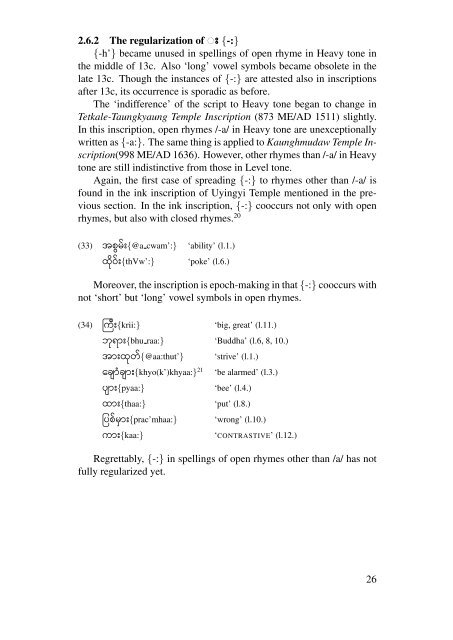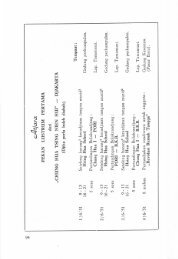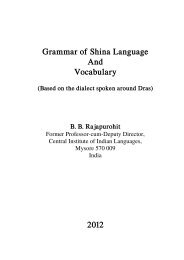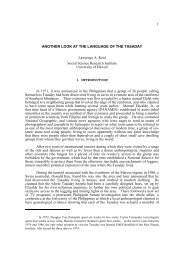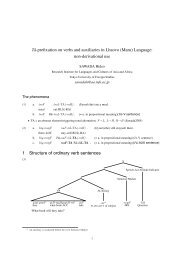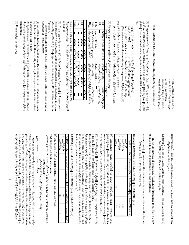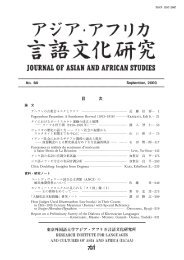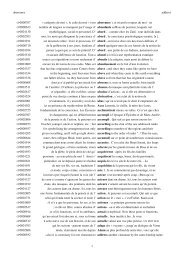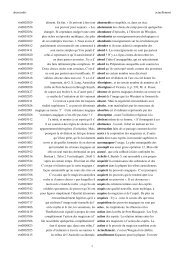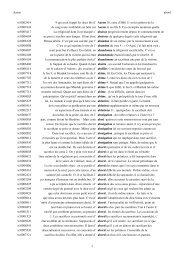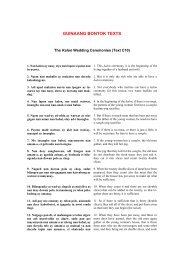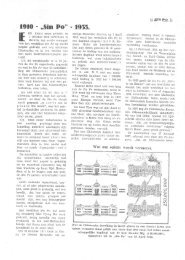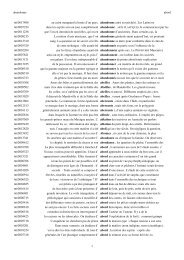Tonal Notation of Indic scripts in Mainland Southeast Asia
Tonal Notation of Indic scripts in Mainland Southeast Asia
Tonal Notation of Indic scripts in Mainland Southeast Asia
Create successful ePaper yourself
Turn your PDF publications into a flip-book with our unique Google optimized e-Paper software.
2.6.2 The regularization <strong>of</strong> ß: {-:}<br />
{-h’} became unused <strong>in</strong> spell<strong>in</strong>gs <strong>of</strong> open rhyme <strong>in</strong> Heavy tone <strong>in</strong><br />
the middle <strong>of</strong> 13c. Also ‘long’ vowel symbols became obsolete <strong>in</strong> the<br />
late 13c. Though the <strong>in</strong>stances <strong>of</strong> {-:} are attested also <strong>in</strong> <strong>in</strong>scriptions<br />
after 13c, its occurrence is sporadic as before.<br />
The ‘<strong>in</strong>difference’ <strong>of</strong> the script to Heavy tone began to change <strong>in</strong><br />
Tetkale-Taungkyaung Temple Inscription (873 ME/AD 1511) slightly.<br />
In this <strong>in</strong>scription, open rhymes /-a/ <strong>in</strong> Heavy tone are unexceptionally<br />
written as {-a:}. The same th<strong>in</strong>g is applied to Kaunghmudaw Temple Inscription(998<br />
ME/AD 1636). However, other rhymes than /-a/ <strong>in</strong> Heavy<br />
tone are still <strong>in</strong>dist<strong>in</strong>ctive from those <strong>in</strong> Level tone.<br />
Aga<strong>in</strong>, the first case <strong>of</strong> spread<strong>in</strong>g {-:} to rhymes other than /-a/ is<br />
found <strong>in</strong> the <strong>in</strong>k <strong>in</strong>scription <strong>of</strong> Uy<strong>in</strong>gyi Temple mentioned <strong>in</strong> the previous<br />
section. In the <strong>in</strong>k <strong>in</strong>scription, {-:} cooccurs not only with open<br />
rhymes, but also with closed rhymes. 20<br />
(33) acW`m¸:{@a<br />
cwam’:} ‘ability’ (l.1.)<br />
Tuiw¸:{thVw’:}<br />
‘poke’ (l.6.)<br />
Moreover, the <strong>in</strong>scription is epoch-mak<strong>in</strong>g <strong>in</strong> that {-:} cooccurs with<br />
not ‘short’ but ‘long’ vowel symbols <strong>in</strong> open rhymes.<br />
(34) Ûk¯:{krii:} ‘big, great’ (l.11.)<br />
BurA:{bhu raa:} ‘Buddha’ (l.6, 8, 10.)<br />
aA:Tut¸{@aa:thut’} ‘strive’ (l.1.)<br />
eKYAMKYA:{khyo(k’)khyaa:} 21 ‘be alarmed’ (l.3.)<br />
pYA:{pyaa:} ‘bee’ (l.4.)<br />
TA:{thaa:} ‘put’ (l.8.)<br />
Rp`c¸mHA:{prac’mhaa:} ‘wrong’ (l.10.)<br />
kA:{kaa:} ‘CONTRASTIVE’ (l.12.)<br />
Regrettably, {-:} <strong>in</strong> spell<strong>in</strong>gs <strong>of</strong> open rhymes other than /a/ has not<br />
fully regularized yet.<br />
26


